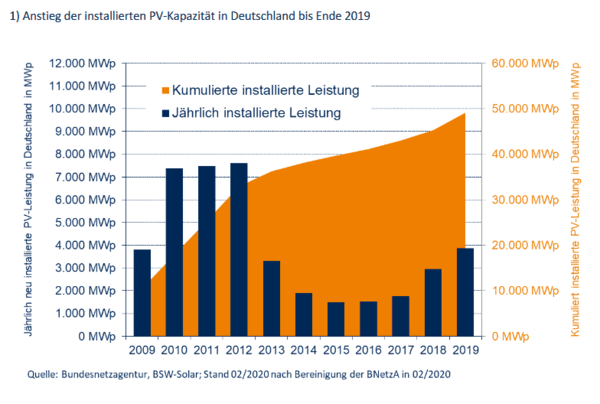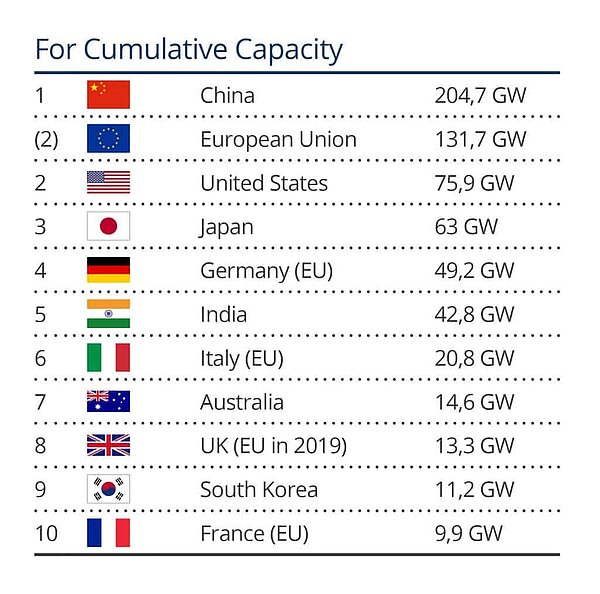Solar Industry and the Corona Crisis
by Vivian Bullinger | 28.05.2020

The crisis is here. Delivery bottlenecks, PV capping, declining capacity additions, but also home offices and canceled trade fairs are causing problems for PV companies in 2020. What can be learned from past crises, what are the strengths of the solar industry, and how can companies cope with the current challenges? To find answers to these questions, we took a closer look at the current situation from different perspectives.
1. A Look Back: The Last Global Crisis - World Financial Crisis 2007
Currently we are in a global crisis - almost every country and every economic sector is affected. A look back can help to find possible ways through the crisis. The last global crisis, the so-called banking crisis or world financial crisis, began in 2007 in the USA and led to the euro crisis.
Banks around the world went bankrupt or were nationalized, and as a result, the national debt of many countries rose sharply. As a result of the crisis, there were production cuts, which led to numerous company collapses, among other things.
In order to overcome the past financial crisis, it was important to recognize the errors and problems and to change or correct them. Also, in the long term, mechanisms - such as banks now having to hold more equity than before, insolvency laws being changed, consumer rights being strengthened - were found to prevent a recurrence. (Source: Wikipedia, World financial crisis) Crises can therefore also be an opportunity to uncover problems or reveal weaknesses in systems and often require new solutions.
2. Strengths and Weaknesses of the Solar Industry
Of course, the solar industry is not immune to the crisis. There are already signs of a 13% decline in new installations (source: PV Magazine, IEA: Covid-19 crisis will reduce renewable installations by 13% in 2020). In such difficult times, it is good to know one's strengths and weaknesses.
Strength: The Solar Industry is Crisis-Experienced
If there is one industry that knows its way around crises or difficult conditions, it is the solar industry. After years of crisis, the German solar market grew again somewhat in 2018. One of the lows was reached with the insolvencies of SolarWorld and Phoenix Solar. These entailed the loss of 100,000 jobs. And yet Detlef Neuhaus, CEO of module manufacturer Solarwatt, declared, "The crisis was the best thing that could ever happen to us." This is despite the fact that he himself went through an insolvency with Solarwatt in 2012. The worst is now over, however, Neuhaus said with conviction. (Source: Handelsblatt, After its severe crisis, the shaken solar industry proclaims its comeback).
Why? Because the crisis has shown that the German solar industry has probably lost the battle for module production. German manufacturers, as well as his company, would have to restructure to do so. The future lies in energy management and battery storage, Neuhaus said. The industry in Germany was developing new business models for renewable photovoltaic power, which was accepted by society.

The upward and downward trend in the industry can also be clearly seen in the installed capacity per year. Despite numerous adversities and major losses, i.e. module production, Germany ranks fourth in a global comparison. With 49.2 gigawatts as of January 2019, Germany has around 40% of all PV installations within the EU.
 Top 10 countries with the highest installed PV capacity in 2019. (Source: IEA PVPS)
Top 10 countries with the highest installed PV capacity in 2019. (Source: IEA PVPS)
Weakness: The Solar Industry is Tied
Two factors have a major impact on the solar industry in Germany: it is heavily dependent on products from China, and tied to the political framework.
Many projects could theoretically continue to be built, but there is currently a shortage of components from China, such as modules and inverters. These supply bottlenecks are causing the PV market a lot of trouble, partly because of the high deadline pressure.
In the area of political framework conditions, limitations on expansion and subsidy programs in particular are constantly presenting the PV industry with new challenges. In Germany, it currently looks like the so-called 52-gigawatt cap for photovoltaics will be lifted, but there is still no concrete timetable for when this is to fall. This means that there is still a factor of uncertainty that can have a particular impact on the planning of new projects. However, political factors do not only influence the PV industry in Germany. In the USA, for example, there is currently high deadline pressure for the expansion of photovoltaics. This is because the tax credits (ITC) for the construction of PV plants are gradually decreasing here from 2020.
3. Finding New Ways in Times of Crisis
The industry is currently facing major challenges that, in most cases, will take time to resolve. In addition, individual companies are facing smaller challenges, but they need a quick solution. Within a very short time, home offices for large parts of the workforce had to be organized and entire trade fair concepts had to be redeveloped. Solare Datensysteme GmbH was also faced with these new tasks and had to find ways to implement them effectively. The fact that Solare Datensysteme GmbH is a medium-sized company was certainly an advantage. Thanks to flat structures and a high degree of flexibility, many things could be implemented faster, in some cases more easily, and perhaps even better.
Time for Digitization
What the "Corona crisis" has already shown us is how important digitization is. Millions of people sit in home offices and depend on the Internet to work. Without this ability to work from home, the economic impact would be much more severe.
The "new" home office, which is truly new on this scale, may initially lead to difficulties. In addition to the technical requirements, processes have to be reorganized. In some cases, this fundamentally changes everyday working life, especially in terms of personal responsibility. In many companies, this has taken on a whole new meaning. A positive side effect is that more personal responsibility boosts motivation. Another point that is now becoming noticeable is the advantage of small teams. These are easier to coordinate in the home office and are therefore usually more effective and less susceptible to crises. In addition, companies whose locations are not near major cities or towns benefit from decentralized workplaces. This is because qualified specialists and managers can be recruited more easily if the new workplace is not associated with a move.
Solare Datensysteme GmbH currently has large parts of its departments in home offices. As a result, the personal responsibility of each individual employee has increased once again, and in addition, everyone has a common goal in mind: to master the crisis as well as possible. So it can already be said that the crisis has further strengthened the sense of unity.
Creative Ways and New Solutions
The motto should be: get out of the comfort zone, move away from problem orientation to result orientation. A very good example of this is the cancellation of this year's Intersolar 2020. How can you still present the new products to customers and how can you turn it into an event? Here, too, the solution lies in digitization. Without further ado, the trade fair is moved to the Internet. The trade show booth is presented online and customers are given the opportunity to find out about new products - just like at a physical trade show. In this case even very comfortably on the PC i.e. from the couch. Corresponding webinars and interesting lectures complement the virtual trade fair program.
Conclusion: The Solar Industry is Flexible, Innovative, and Future-Oriented.
A crisis can help to better recognize grievances and to try something new. The solar industry and its companies are characterized by a high degree of flexibility and creativity. Perhaps this is one of the advantages of a still young industry. Nevertheless, there are also entrenched and outdated structures that are becoming visible as a result of the crisis and that need to be rethought.
These certainly include the supply chains and the resulting dependencies. Does it make sense to produce components predominantly in one country? Would additional production sites be economical? What precautions can be taken to mitigate supply bottlenecks? The current crisis highlights weaknesses in the industry and allows them to be analyzed in greater detail. It remains to be seen whether these analyses will lead to changes and, if necessary, improvements in existing structures.
Together we are strong - this also proves true time and again in difficult times. One way to move forward together is through cooperation. It can help strengthen business locations and bring new products to market faster and more cost-effectively.
Another point in favor of renewable energies is the environmental factor. Increasing global warming will present the world with further major problems. An important factor in slowing down warming is the expansion of renewable energies. PV energy is thus one of the technologies that will most likely be in increasing demand in the future.
There is an opportunity to emerge stronger from the current crisis if the right conclusions are drawn and the strengths of the industry are exploited.
What conclusions have you drawn for yourself, and what conclusions do you think the PV industry should draw? We look forward to your comments!
Back to the overview



